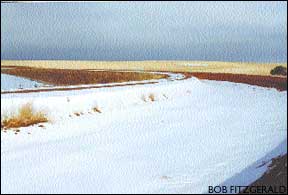|
Jan. 25, 2001
By Jim Mimiaga Construction costs will dictate whether or not dryland farmers seeking new irrigation water can be served by a proposed delivery project, the Dolores Water Conservancy District board decided this month. And some landowners who signed up for the water by an October 1999 district deadline may be left out to dry, as managers could be forced by economics to choose some of those who signed up late. "That is the direction we need to go, and the public notice to sign up for this water clearly states that we would do what was in the best interest of the district ó and that means priority to lands that we can reach most economically," said Don Schwindt, DWCD board president. Fifty landowners with a total of 13,000 acres near the Dove Creek Canal have signed up for the chance to receive the "new" water under a still-pending, $8 million expansion plan sought by the district. But once on-line, the project ó already approved for funding by the stateís top water board ó will only be able to deliver water for 4,000 additional acres. McPhee Reservoir irrigates 68,000 acres of land in all. The districtís plan involves purchasing 6,000 acre-feet of water from the Montezuma Valley Water Company for $2.25 million. A pumping station would be installed at Totten Lake to access the purchase water. Then a series of pumps, laterals, and irrigation boxes costing $5 million would be constructed off of the Dove Creek Canal to water croplands currently dry-farmed. If the project does go forward, deciding who receives the water will depend on which lands can be accessed most affordably by a series of canals that would spur off of the Dove Creek Canal, McPhee Reservoirís main delivery system. The district is bracing for a potentially contentious public hearing on the issue. Thatís because some landowners who signed up for the new water before the districtís own deadline may get bumped by late signers whose lands happen to be closer to the Dove Creek Canal and is therefore more cost-effective to reach. "It always comes down to money, and the savings to the district are substantial if we serve lands that are easier to access," said board member Jim Fisher. By serving lands that are more accessible, the district will save approximately $1 million, according to the district. The public hearing to allot the water will be held this spring, the board said. Various cost-benefit scenarios and configurations of where the new canals, laterals and pump stations would be located were discussed at length by the board water engineers, and the Bureau of Reclamation. "Itís a tough issue," said district general manager John Porter. "Delivering the water to late signers reduces our costs, but then it is not totally first-come, first-served." The districtís project, which is being challenged by environmental groups and is opposed by the rafting community, has an uncertain future. Recently, the planís validity was questioned by Trout Unlimited and Environmental Defense. Both groups cited an environmental report showing that the water being purchased by the district for expanding irrigated lands should flow downstream for fish habitat instead. The project is pending a biological opinion from the U.S. Fish and Wildlife Service on the effects, if any, the proposed project has on downstream fisheries below the dam. |
||
|
Copyright © 2001 the Cortez Journal.
All rights reserved. |
